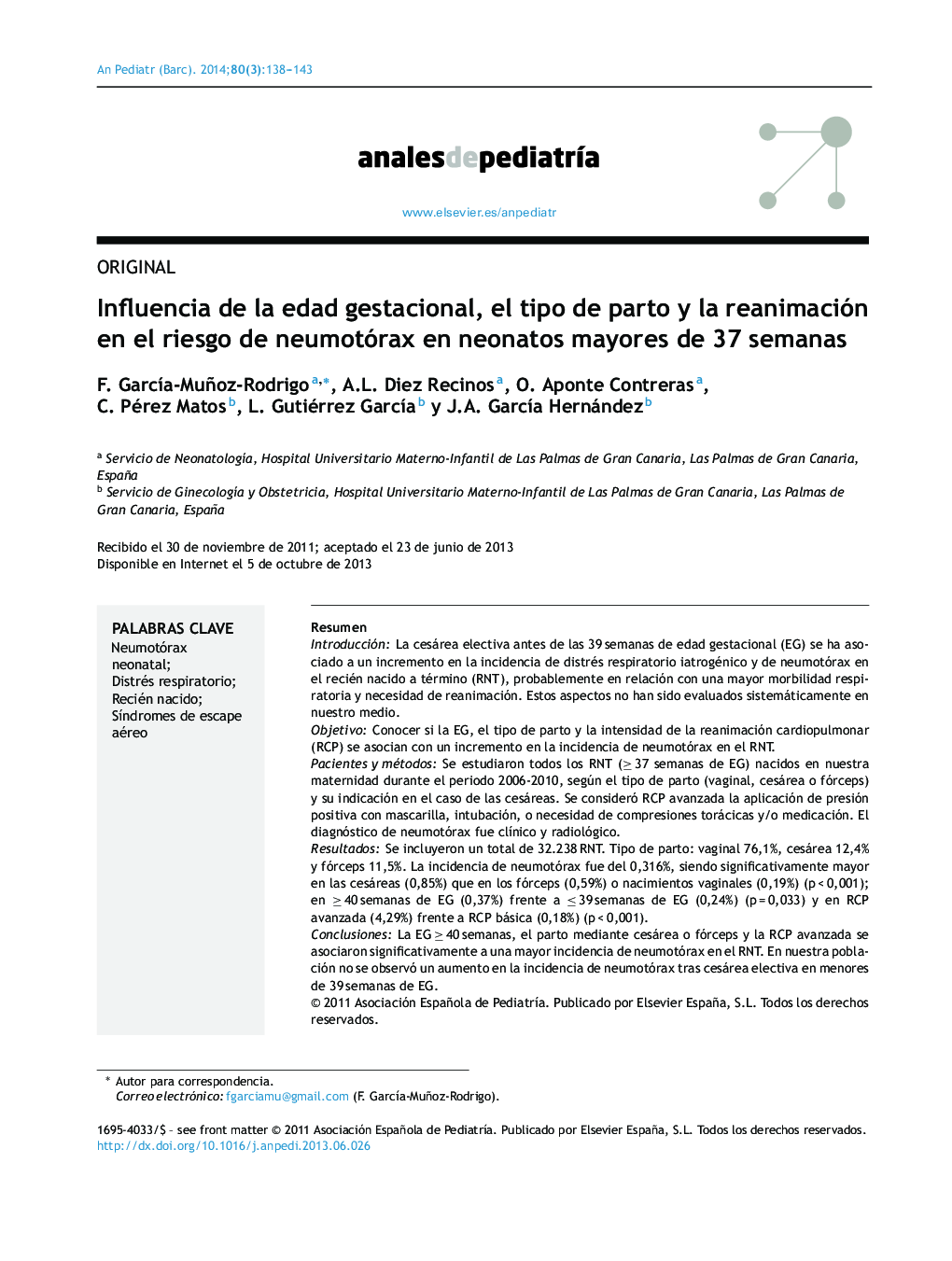| کد مقاله | کد نشریه | سال انتشار | مقاله انگلیسی | نسخه تمام متن |
|---|---|---|---|---|
| 4141525 | 1272331 | 2014 | 6 صفحه PDF | دانلود رایگان |
ResumenIntroducciónLa cesárea electiva antes de las 39 semanas de edad gestacional (EG) se ha asociado a un incremento en la incidencia de distrés respiratorio iatrogénico y de neumotórax en el recién nacido a término (RNT), probablemente en relación con una mayor morbilidad respiratoria y necesidad de reanimación. Estos aspectos no han sido evaluados sistemáticamente en nuestro medio.ObjetivoConocer si la EG, el tipo de parto y la intensidad de la reanimación cardiopulmonar (RCP) se asocian con un incremento en la incidencia de neumotórax en el RNT.Pacientes y métodos Se estudiaron todos los RNT (≥ 37 semanas de EG) nacidos en nuestra maternidad durante el periodo 2006-2010, según el tipo de parto (vaginal, cesárea o fórceps) y su indicación en el caso de las cesáreas. Se consideró RCP avanzada la aplicación de presión positiva con mascarilla, intubación, o necesidad de compresiones torácicas y/o medicación. El diagnóstico de neumotórax fue clínico y radiológico.ResultadosSe incluyeron un total de 32.238 RNT. Tipo de parto: vaginal 76,1%, cesárea 12,4% y fórceps 11,5%. La incidencia de neumotórax fue del 0,316%, siendo significativamente mayor en las cesáreas (0,85%) que en los fórceps (0,59%) o nacimientos vaginales (0,19%) (p < 0,001); en ≥ 40 semanas de EG (0,37%) frente a ≤ 39 semanas de EG (0,24%) (p = 0,033) y en RCP avanzada (4,29%) frente a RCP básica (0,18%) (p < 0,001).ConclusionesLa EG ≥ 40 semanas, el parto mediante cesárea o fórceps y la RCP avanzada se asociaron significativamente a una mayor incidencia de neumotórax en el RNT. En nuestra población no se observó un aumento en la incidencia de neumotórax tras cesárea electiva en menores de 39 semanas de EG.
BackgroundElective caesarean section before 39 weeks gestational age (GA) has been associated with a higher incidence of iatrogenic respiratory distress and pneumothorax in term newborn babies, probably because of a higher respiratory morbidity and the need for resuscitation. These factors have not been systematically evaluated in our patients.ObjectiveTo determine whether the gestational age, type of delivery, and intensity of resuscitation, are associated with an increase in the incidence of pneumothorax in term neonates.Patients and methodsFull term neonates (≥ 37 weeks GA) born in our maternity unit from January 2006 to December 2010 were studied, along with the type of delivery (vaginal, forceps or caesarean section). Advanced cardiopulmonary resuscitation (CPR) was defined as the need of bag and mask intermittent ventilation, intubation, chest compression, and/or administration of medication. The diagnosis of pneumothorax was clinical and radiological in all cases.ResultsA total of 32,238 full term newborns were included. Type of delivery: vaginal 76.1%, C-section 12.4%, and forceps 11.5%. The incidence of pneumothorax was 0.316%. It was significantly higher in C-section (0.85%), than in forceps (0.59%), or non-instrumental vaginal deliveries (0.19%) (P < .001), and in infants ≥ 40 weeks GA (0.37%) compared to ≤ 39 weeks GA (0.24%) (P = .033), and in advanced CPR (4.29%) compared to basic CPR (0.18%) (P < .001).ConclusionsA GA ≥ 40 weeks, C-section, or forceps delivery, and advanced CPR immediately after birth were significantly associated with a higher incidence of pneumothorax in full term newborn babies. In our population, we did not observe an increase in pneumothorax among neonates born by elective C-section before 39 weeks of gestation.
Journal: Anales de Pediatría - Volume 80, Issue 3, March 2014, Pages 138–143
